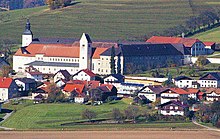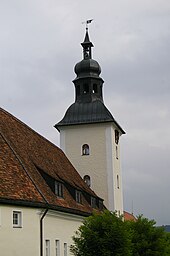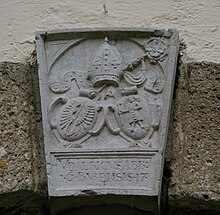Benedictine Abbey Michaelbeuern
The Benedictine Abbey Michaelbeuern ( S. Michaelis Archangelis apud Beurn ) is a monastery founded in the 8th century in today's Dorfbeuern in the Salzburger Land in Austria , about 30 kilometers north of the city of Salzburg .
Foundation and history of Michaelbeuern
Already at the time of the Salzburg Abbot Bishop Flobrigis there was a monk's cell here around 736, which in 817 is referred to as "Buria" in the Aachen monastery directory. After the interruption of monastic life and work due to the Hungarian Wars, reconstruction began in 977 with the donation of goods by Emperor Otto II . Under Count Palatine Hartwig I , the abbey was re-founded, and the most important families in the country carried out its renovation in the high Middle Ages . After the glamorous re-consecration of the Romanesque pillar basilica on July 18, 1072 by the Patriarch Sighard of Aquileia and Archbishop Gebhard of Salzburg , Michaelbeuern was a noble double monastery , which however soon became extinct again.
Werigand is the first abbot of the monastery known by name. His reign is dated from 1072 to 1100. Michaelbeuern flourished under Abbot Walther (1161–1190); he acquired the giant Bible named after him , which was written around 1140. The monks increasingly took on pastoral care in the surrounding communities, such as in Seewalchen am Attersee , Obersulz and in the 18th district of Vienna , where the Michelbeuern district (now in the 9th district of Alsergrund ) on the Gürtel is named after the monastery. There is evidence of a convent school as early as the 13th century, which later also trained choirboys.
Times of crisis, caused by natural disasters such as the fire in 1364, by mismanagement in the granting of benefices and the effects of the Reformation , when the convent only comprised three monks, were only briefly interrupted by phases of upswing, such as those related to the implementation of the Melk monastery reform under Abbot Georg (1440–1472) followed.
Michaelbeuern's long-term consolidation only began in the 17th century, which was reflected in spirituality , far-reaching pastoral and educational tasks and extensive construction activities. Around twenty-five monks lectured at the Benedictine University of Salzburg .
Important artists of the time, the sculptor Meinrad Guggenbichler and the painter Johann Michael Rottmayr , created the widely known high altar in the baroque collegiate church. Under Abbot Anton Moser Convention floor and library were rebuilt, the abbey hall in 1771 by Franz Nikolaus Streicher frescoed . In 1835, the former Augustinian hermit monastery in Salzburg-Mülln was transferred to the monastery, whereby the monks in today's parishes of Mülln and Maxglan took on pastoral tasks until September 2008 .
During the Nazi era, the school and church were closed and the monks were expelled. Soon after the Second World War , monastic life was restarted, and in 1950 the reromanized collegiate church was consecrated again.
The modern renewal of the monastery continues under the current abbot Johannes Perkmann . Visible expression for this is u. a. the renovation and revitalization of the entire former economic wing of the monastery as a school and education center and the restoration of the collegiate church with the construction of the Eisenbarth organ.
Current tasks
By running a school and a boarding school, the monks from Michaelbeuern try to give young people help in holistic personal development. The retreat and education house wants to convey Benedictine spirituality to people who are looking for silence, reflection and religious deepening in retreats, retreats, temporary monastery and in further training of parish staff.
In addition, monks are active as pastors in four parishes in the city and province of Salzburg and Upper Austria ( Perwang , Salzburg-Mülln , Lamprechtshausen and the Dorfbeuern monastery parish). The parish Salzburg-Maxglan was transferred to the Archdiocese of Salzburg in September 2008.
As a culture preserver, the abbey endeavors not only to make the church cultural assets entrusted to it for centuries accessible in a museum setting, but also to make them tangible as part of their sacred environment and living function.
Like every Benedictine monastery, Michaelbeuern are affiliated with commercial enterprises. The monastery operates a farm, a biogas plant and a district heating plant that supplies the monastery and some households in the village. The monastery has also had a 50 percent share in the Augustiner Bräu Kloster Mülln since the 19th century. Opposite the abbey is the Stiftskellnerei, a restaurant that is housed in a former farm building of the monastery and was leased by them.
In 2012 the boarding school was closed, and starting with the 2013/14 school year, the secondary school became a new middle school .
Abbey church
Even before the rededication of the Romanesque pillar basilica on July 18, 1072 by the Patriarch Sieghard von Aquileia and Archbishop Gebhard von Salzburg , there was an older church building in Michaelbeuern. Significant artists in the Baroque style of the abbey church in the 17th century included: a. the sculptor Meinrad Guggenbichler and the painter Johann Michael Rottmayr . They created the widely known high altar around 1691. During the National Socialist rule the church was closed and the monks were expelled. When monastic life began again soon after the war, the partially reromanized collegiate church was consecrated again in 1950.
See also
literature
- Stefan Engels: Michaelbeuern. In: Oesterreichisches Musiklexikon . Online edition, Vienna 2002 ff., ISBN 3-7001-3077-5 ; Print edition: Volume 3, Verlag der Österreichischen Akademie der Wissenschaften, Vienna 2004, ISBN 3-7001-3045-7 .
- Michael Filz: History of the Salzburg Benedictine monastery Michaelbeuern . 2 volumes. Salzburg 1833 (Volume 1: digitized ; Volume 2: digitized )
- Christian art sites in Austria No. 375, Verlag St.Peter, Salzburg 2001
Web links
Individual evidence
- ↑ Harald Mattel takes over the parish Maxglan , Vienna online, June 23, 2008.
- ^ Private new middle school of the Benedictine Abbey Michaelbeuern inaugurated . Salzburg state correspondence, June 3, 2018.
Coordinates: 48 ° 1 ′ 13 ″ N , 13 ° 1 ′ 47 ″ E










